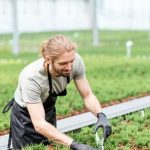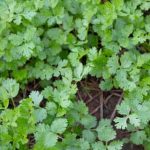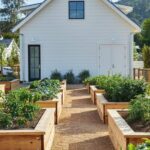Are you looking for an easy to use vegetable gardening guide to help get your garden started? Look no further. Whether you are a seasoned gardener or just starting out, this comprehensive guide will give you the tips and techniques you need to successfully grow your own vegetables at home.
Vegetable gardening is not only a rewarding hobby, but also an important skill to have. With concerns about food security and the environmental impact of industrial farming, growing your own produce can contribute to a more sustainable lifestyle. In addition to the benefits for the planet, gardening can also be good for your health, as it provides exercise, fresh air, and nutritious food.
In this section, we will introduce the importance and benefits of vegetable gardening. From selecting the right location for your garden to choosing the best vegetables for beginners to grow, we will provide you with all the information you need to get started on your vegetable gardening journey. So roll up your sleeves and get ready to learn how easy and fulfilling it can be to grow your own vegetables.
Selecting the Right Location for Your Vegetable Garden
Sunlight and Shade
One of the most important factors to consider when selecting a location for your vegetable garden is sunlight. Most vegetables require at least 6-8 hours of direct sunlight per day, so it’s essential to choose a spot that receives adequate sunlight. Avoid placing your garden in areas that are heavily shaded by trees or buildings, as this can hinder the growth of your plants.
Soil Quality
The quality of the soil in your chosen location is also crucial. Vegetables thrive in well-draining, nutrient-rich soil. Consider conducting a soil test to determine its pH and nutrient levels. If necessary, amend the soil with organic matter such as compost or aged manure to improve its texture and fertility.
Accessibility and Water Source
Lastly, consider the accessibility of your chosen location and the proximity to a water source. You’ll want your vegetable garden to be easily accessible for planting, watering, weeding, and harvesting. Additionally, having access to a water source such as a hose or irrigation system will make it easier to keep your plants adequately hydrated throughout the growing season.
By carefully considering these factors when selecting the right location for your vegetable garden, you can set yourself up for success and ensure that your plants thrive throughout the growing season. With these tips in mind, you’ll be well on your way to creating a beautiful and productive vegetable garden using this easy-to-use vegetable gardening guide.
Choosing the Best Vegetables for Beginners to Grow
When starting a vegetable garden, it’s important to choose the right vegetables that are easy to grow and maintain for beginners. Selecting the best vegetables for beginners can help build confidence and success in gardening. There are several factors to consider when choosing which vegetables to grow, such as climate, available space, and personal preferences. This section will provide guidance on selecting the best vegetables for beginners to grow in their vegetable garden.
Consider Your Climate and Growing Season
It’s important to consider your local climate and growing season when choosing which vegetables to grow. Some vegetables thrive in cooler temperatures, while others prefer warmer weather. Research which vegetables are suitable for your specific climate and growing season to ensure successful growth.
Choose Low-Maintenance Vegetables
For beginners, it’s advisable to choose low-maintenance vegetables that require minimal care and attention. Vegetables such as lettuce, bush beans, radishes, and tomatoes are relatively easy to grow and do not require extensive maintenance. These types of vegetables can be a great starting point for those who are new to gardening.
Grow Vegetables You Enjoy Eating
When selecting which vegetables to grow in your garden, consider the ones you enjoy eating. Growing vegetables that you like can make the gardening experience more enjoyable and rewarding. It can also motivate you to take better care of your plants and look forward to harvesting them.
By considering these factors when choosing the best vegetables for beginners to grow, you can set yourself up for a successful vegetable gardening experience. Whether it’s considering your local climate, selecting low-maintenance options, or growing vegetables you enjoy eating, making informed choices at this stage will contribute greatly to the overall success of your garden. With this easy-to-use vegetable gardening guide, you’ll be well on your way to cultivating a thriving and abundant vegetable garden.
Preparing the Soil for Planting
One of the most crucial steps in starting a successful vegetable garden is to prepare the soil properly. Healthy soil provides the essential nutrients and support that plants need to thrive, resulting in higher yields and better-tasting vegetables. Before planting, it’s important to assess the soil quality and make any necessary improvements.
The first step in preparing the soil is to test its pH and nutrient levels. You can do this by purchasing a DIY soil testing kit or by sending a sample to a local agricultural extension office. Once you have an understanding of your soil’s composition, you can then make adjustments as needed. Adding organic matter such as compost or aged manure can help improve soil structure, drainage, and nutrient content.
In addition to adding organic matter, consider incorporating fertilizer based on your soil test results. This will ensure that your plants have access to the necessary nutrients for healthy growth. It’s also important to till the soil to loosen it up before planting. Thoroughly mixing in compost and fertilizer will provide an optimal environment for your vegetable garden to flourish.
| Nutrient | Function |
|---|---|
| Nitrogen | Stimulates leafy green growth |
| Phosphorus | Promotes root development and flower/fruit production |
| Potassium | Aids in overall plant health and disease resistance |
By following these tips for preparing your soil, you can set your vegetable garden up for success from the very beginning. Taking the time to properly care for your soil will pay off with bountiful harvests of delicious, homegrown produce.
As you learn about preparing the ideal conditions for growing your vegetables, keep in mind specific varieties thrive under special circumstances.
Planting and Watering Your Vegetable Garden
Planting Your Vegetables
- Start by preparing the soil according to the specific requirements of each vegetable you plan to plant. This may include adding compost, mulch, or other organic materials.
- Follow the recommended spacing for each type of vegetable to ensure they have enough room to grow without competing for nutrients and sunlight.
- When planting seeds, be sure to plant them at the correct depth and cover them with soil. For seedlings, carefully transplant them into the soil, being mindful not to damage their delicate roots.
Watering Your Vegetable Garden
- Water your garden deeply but infrequently to encourage deep root growth. Shallow watering can lead to shallow roots, making plants more susceptible to drought.
- Water in the early morning or late afternoon to minimize evaporation and give plants time to dry before cooler nighttime temperatures arrive.
- Keep an eye on the weather and adjust your watering schedule accordingly. During hot, dry periods, you may need to water more frequently, while cooler or rainy weather may require less frequent watering.
These step-by-step instructions for planting and watering your vegetable garden will help set you on the path to a successful harvest. By following these guidelines and staying attentive to the needs of your plants, you can ensure that they receive the care they need to thrive.
Easy Maintenance
When it comes to maintaining a successful vegetable garden, controlling pests and weeds is crucial. Here are a few tips to help you keep your garden healthy and thriving:
- Regular Inspection: One of the easiest ways to control pests and weeds is to regularly inspect your plants. Look for any signs of infestation or weed growth, and address the issue as soon as possible.
- Natural Predators: Encourage natural predators, such as ladybugs or lacewings, to help control pest populations in your garden. You can also introduce beneficial insects like praying mantises or nematodes.
- Organic Pest Control: Utilize organic pest control methods, such as neem oil or insecticidal soap, to minimize damage from pests without harming beneficial insects or the environment.
In addition to pests, weeds can also hinder the growth of your vegetables. Here are some tips for weed management:
- Mulching: Mulch around your plants to suppress weed growth and retain moisture in the soil. This will also help maintain a more consistent soil temperature.
- Hand Pulling: Regularly hand pull any visible weeds to prevent them from taking over your garden space. Be sure to remove the entire root system to prevent regrowth.
- Crop Rotation: Practice crop rotation each season to disrupt weed growth patterns and reduce the likelihood of weed infestations in specific areas of your garden.
By implementing these easy maintenance tips for controlling pests and weeds, you can ensure a bountiful harvest from your vegetable garden while minimizing the use of harmful chemicals.
Harvesting Your Vegetables
One of the most rewarding aspects of vegetable gardening is being able to harvest and enjoy the fruits of your labor. Knowing when and how to properly harvest your vegetables can make a significant difference in taste, quality, and productivity. Here are some tips to help you make the most of your harvest:
First, it’s important to understand that different vegetables have different indicators for optimal harvesting. For example, tomatoes should be harvested when they are fully colored and firm to the touch, while lettuce is best harvested in the morning before the sun has a chance to wilt the leaves. Researching each vegetable you plant will give you specific information on when it is ready for picking.
In addition to timing, knowing how to properly harvest your vegetables is crucial for ensuring their taste and longevity. Using a sharp pair of scissors or pruning shears can prevent damage to plants and help them continue producing throughout the growing season. Properly storing harvested vegetables in a cool and dark place can also extend their shelf life.
Lastly, it’s important to consider that some vegetables, like zucchini and cucumbers, should be harvested frequently to encourage new growth. By regularly checking your garden for ripe produce, you can ensure that each plant reaches its full potential.
| Vegetable | Best Harvest Time |
|---|---|
| Tomatoes | Fully colored and firm |
| Lettuce | Morning before sun wilts leaves |
| Zucchini/Cucumbers | Frequently for new growth |
Additional Resources and Tools for a Successful Vegetable Garden
In addition to the basic knowledge and tools needed for a successful vegetable garden, there are several resources and additional tools that can further enhance your gardening experience. One important resource is online gardening forums and communities where you can connect with other gardeners, ask questions, and share tips and advice. These communities are valuable sources of information, support, and inspiration.
Another resource that can be incredibly helpful for beginner gardeners is a comprehensive gardening book or guide specifically tailored to vegetable gardening. A well-written book can provide in-depth information on plant care, soil health, pest management, and more. Look for a guide that is easy to understand and provides practical advice that you can apply to your own garden.
When it comes to tools, investing in high-quality hand tools such as trowels, pruners, and hand weeders can make the gardening process much easier and more enjoyable. Additionally, consider purchasing a soil test kit to monitor the health of your soil and make informed decisions about fertilization. These additional resources and tools will complement the knowledge gained from this easy to use vegetable gardening guide and help you achieve even greater success in your garden.
Lastly, don’t underestimate the power of local agricultural extension offices or nurseries for expert advice tailored to your specific region. They often offer classes or workshops on topics relevant to local growing conditions and can provide personalized guidance based on your unique gardening challenges. Take advantage of these in-person resources for a well-rounded approach to cultivating a thriving vegetable garden.
Conclusion
In conclusion, starting a vegetable garden can be a rewarding and fulfilling experience for anyone, whether you have a green thumb or are completely new to gardening. The Easy to Use Vegetable Gardening Guide provides valuable information and step-by-step instructions for beginners to successfully grow their own vegetables. By following the tips and techniques outlined in this guide, you can enjoy the benefits of having fresh, flavorful produce right at your fingertips.
As you embark on your vegetable garden journey, it’s important to remember that patience and dedication will be key to your success. Gardening is a learning process, and there may be some trial and error along the way. However, with the knowledge and resources provided in this guide, you will be well-equipped to handle any challenges that may arise.
So, whether you have a small backyard or just a few pots on your balcony, don’t be afraid to get your hands dirty and start planting. With the Easy to Use Vegetable Gardening Guide as your companion, you’ll soon be enjoying the satisfaction of growing your own delicious vegetables while reaping all the benefits that come with it.
Frequently Asked Questions
What Vegetables Should I Garden for Beginners?
For beginners, it’s best to start with easy-to-grow vegetables like tomatoes, lettuce, peppers, carrots, and zucchini. These vegetables are relatively low-maintenance and can thrive in various growing conditions.
What Is the Most Efficient Vegetable Garden Layout?
The most efficient vegetable garden layout depends on the space you have available and the types of vegetables you want to grow. However, a common efficient layout is using raised beds or square foot gardening to maximize space and make it easier to access your plants for maintenance.
How Do You Plan a Simple Vegetable Garden?
To plan a simple vegetable garden, start by choosing a suitable location with good sunlight and soil drainage. Then, decide on the vegetables you want to grow and their spacing requirements. Next, prepare the soil by adding compost or fertilizer. Finally, plant your chosen vegetables following their specific planting instructions.

If you’re looking to get into vegetable gardening, or are just looking for some tips on how to make your current garden better, then you’ve come to the right place! My name is Ethel and I have been gardening for years. In this blog, I’m going to share with you some of my best tips on how to create a successful vegetable garden.





